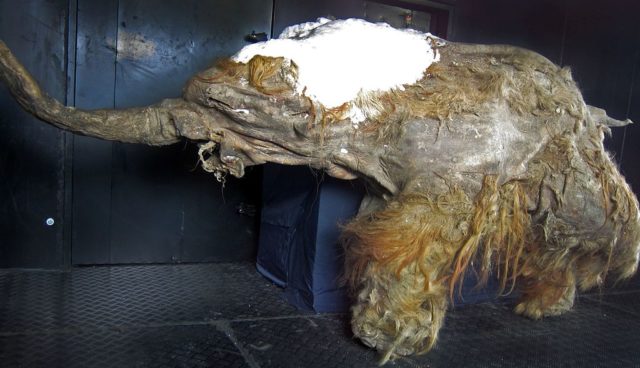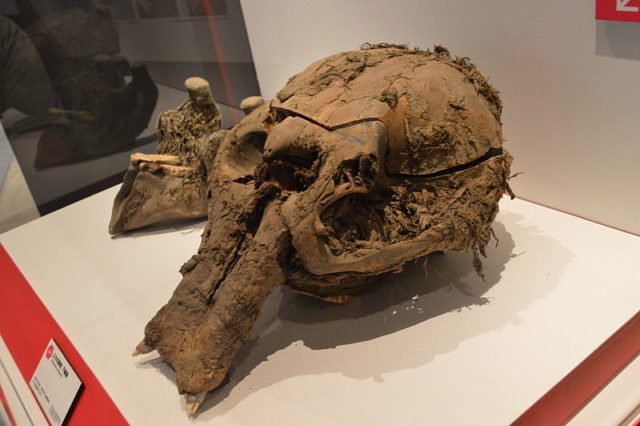The remains of a woolly mammoth were discovered in the Siberian permafrost in 2009, she was named Yuka, and only recently have scientists began to analyze her brain.
Scientists have said that her brain is so well preserved that they can actually perform a full-scale brain scan on her; they will be doing this so they can get a better understanding of the woolly mammoth’s brain anatomy.
For a while now, scientists have wanted to start “bringing these type of creatures back to life” using modern technology.
The original findings were presented at the 73rd Symposium of the Society of Vertebrate Paleontology in Los Angeles.
The findings show the breakthrough that came with the first CT scan of the cranium. The first CT was performed at the Republic of Sakha Academy of Sciences, Yakutsk in 2012 to understand the morphology of Yuka’s molars.

“It unexpectedly revealed the preserved brain with well-defined major gross anatomy features, including frontal, temporal, and parietal lobes with gyri, and cerebellum with internal structures, which yielded the first chance to examine woolly mammoth brain morphology,” said the Yakutsk team.
“The brain extraction was performed based on our own experience combined with the generally used treatment for large mammals, including modern elephants.”
“In February 2013, the brain was preserved by the method of flowing fixation developed by Professor Sergei Saveliev (Research Institute of Human Morphology, Russian Academy of Medical Sciences (RIHM, RAMS) in Moscow), which included three weeks of continuous preservation of the braincase content only using formalin.”
“The skull trepanation was performed on 25 February in Yakutsk’ – and is shown in our pictures. After the extraction, the brain was wrapped with fabric for support and placed into formalin solution overnight before being flown to Moscow. It is currently stored in formalin solution at the Research Institute of Human Morphology.”
The first results of the research confirm “similar morphology to the brain of modern elephants”, however much deeper research is need.
They say that the brain was dehydrated because of the mummified state that Yuka was in, there was also some shrinkage. Yuka’s brain turned brown because of oxidation, just like the way that copper turns green because of it.
Crucially “scientists have identified the main functional areas of the brain, making it possible to talk about creating a brain atlas,” said a report by Professor Albert Protopopov and colleagues. This will proceed in Moscow, he said, at the Institute of Human Morphology under the guidance of Professor Saveliev.

“This discovery holds great scientific significance. This is the first time scientists have got their hands on the brain of an animal that lived tens of thousands of years ago, and one that is in such good condition,’ said Professor Protopopov. “The woolly mammoth brain research will help academics ‘to understand particular aspects of their behaviour.”
This is the first mammoth brain to be discovered, all others succumbing to “dehydration or rotting.” Yuka was only around ten years when she died.
The mammoth’s brain was not the largest of all the land animals. “Dinosaurs were still larger,” Protopopov said, “as were Colombian mammoths in North America. Our woolly mammoths were smaller.”
Gennady Boeskorov confirmed to the symposium that even with Yuka looking so life-like, her body contained no living cells.
“Initially, we need a living cell for the scientific process organization, but unfortunately, the corpse of Yuka does not contain any,” he said. “Now, scientists from around the world are working to decipher the DNA of a mammoth.
If it is successfully completed, the next step will be the re-creation of its similarity and implantation of its nucleus into an elephant cell. Theoretically, it is possible, but practically, no one in the world has been able to carry out such an experiment, which will take a lot of time.”
Even so, Yuka is being examined to unlock the mysteries of time, and her body is making many museum-goers very happy. She is currently touring the world and after a very successful visit in Japan, she is off to Taiwan.
